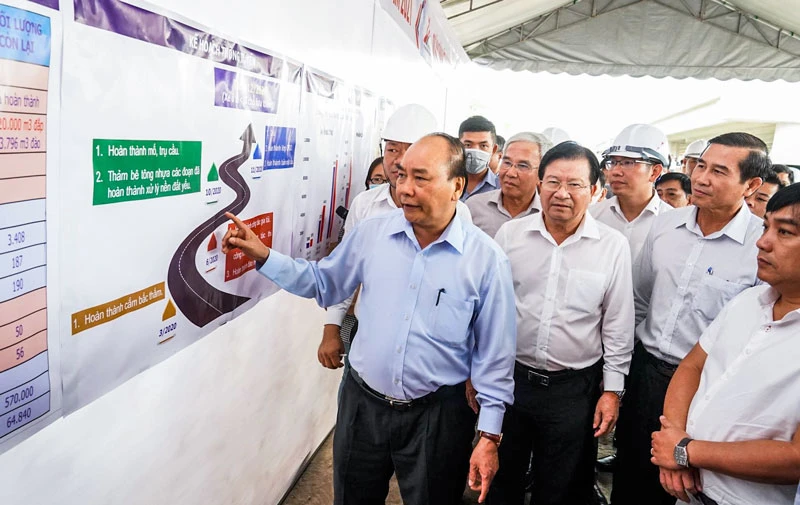
The Trung Luong-My Thuan Expressway will have a length of 55.1km and four lanes. It will reduce the travel time between Ho Chi Minh City and the Mekong Delta and reduce congestion on National Highway 1.
The Prime Minister visited the site in early March and informed that land clearance for the build-operate-transfer (BOT) project has been completed and 35% of the workload has been fulfilled. The Prime Minister praised the project’s main investor, contractors and relevant agencies for their efforts in land clearance and restarting of the construction work. To speed up the progress of the project, the Prime Minister asked the People’s Committee of Tien Giang Province to allocate the remaining investment capital promptly, while also dealing with saltwater intrusion in order to facilitate the construction.
Delays in key transport projects
The construction of the Trung Luong-My Thuan Expressway in Phu Nhuan Commune in Tien Giang Province in the Mekong Delta Region will provide an important transport link to connect the current Ho Chi Minh City-Trung Luong Expressway and My Thuan-Can Tho Expressway to thirteen Mekong Delta Provinces and to Ho Chi Minh City, creating a complete and effective transport network.
People were not very happy with the delay in this key project which was restarted after being on hold for last ten years. The construction began in 2009, but was stalled due to a lack of funds. When construction work restarted workers remained on the site even during the Tet holiday season to ensure the work progressed as per schedule.
Similarly, the Ben Luc-Long Thanh expressway is a key national project at a total investment of more than USD 1.5 bn, which will connect the West with Ho Chi Minh City and key economic regions in the south, on which construction had begun some six years ago but had been on hold since.
Problems of lack of funds, administrative bottlenecks were the main causes of delay. Conflicts in authority between the Ministry of Transport and the State Capital Management Committee, and legalities in determining the properties of projects invested by the Vietnam Expressway Corporation (VEC) added to the shelving of the expressway project as well.
Both the highways in the West and the East of the Mekong Delta Region have faced obstacles since the very start of the projects. Up to now, the Southwest region is where the highest highway is most needed. While the whole country has about 1,000 km of highways, the Mekong Delta Region that provides 60% of the country’s GDP, and contributes about 70% towards the national budget, still lacks an effective transport infrastructure.
More investment required
According to a report by the Ministry of Transport, in the period 2011-2015, investment in transport infrastructure in the Mekong Delta Region was very low, while there is an urgent need for more capital as the transportation system within the Mekong Delta Region is far too weak and ineffective. However, some key transport projects in the region such as the Vam Cong Bridge and Cao Lanh Bridge have been completed, and the My Thuan 2 Bridge under North-South Expressway Project has begun construction.
Development of transport infrastructure in the Mekong Delta is facing problems of small capital and large investment needs. It is necessary to promote the socialization and diversification of investment modes, including attracting private investments through BOT, BTO and PPP for building of bridges and roads. However, the downside of socializing traffic is also another bottleneck that needs to be cleared. The fact that toll booths proved ineffective in the past as they were burdens that only increased fees on products and services for businesses and people.
People only believe in the future when looking at the present action plan and the way the government is tackling current problems such as the construction implementation of these all-important transport infrastructure projects.




















